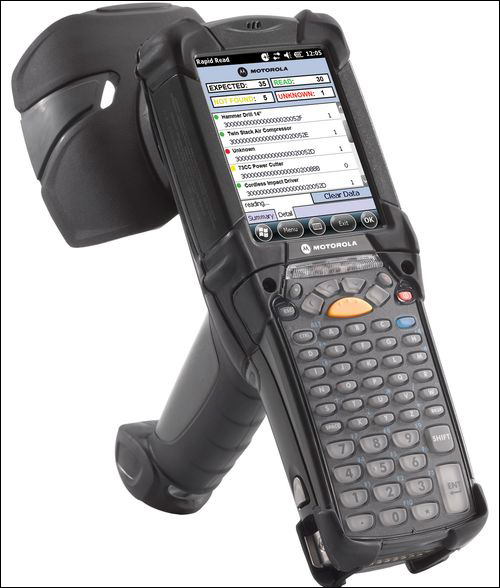Motorola Solutions has released an updated version of its industrial handheld RFID reader, known as the MC9190-Z. The new device’s predecessor, the MC9090-Z model, will be discontinued, with the remaining supply to be sold through the first half of 2013. According to the company, the MC9190-Z device promises improved RFID read performance, due to a faster processor, as well as greater memory, thereby increasing the rate at which data received from each read is processed.
The MC9190-Z reader contains 256 megabytes or 1 gigabyte of memory, a faster processor and an updated Microsoft operating system—Windows Mobile (WM) version 6.5.3, as opposed to WM6.1. It also features a larger color display and three keyboard options, as well as an extended-range laser for bar-code scanning.

The new reader is designed for tough environments, Motorola reports, and has been beta-tested by customers in oil and gas, warehousing and retail environments, in the shipping and receiving areas, as well as by some factory operators. The only customer that has beta-tested the new device and is willing to be named is Singapore logistics firm Toll Global Logistics, which, Motorola indicates, reported being impressed with the larger touch screen and the RFID performance.
The most significant improvement to the new reader, according to Chris Warner, Motorola Solutions’ senior product marketing consultant, is its application performance. The MC9190-Z reader will provide users with faster computing functionality, he says, by virtue of its faster processor and greater memory. As a result, he adds, application performance is improved by approximately 20 percent over that of the MC9090-Z model, ultimately resulting in a slight increase in RFID read rate. However, Warner declines to quantify that increased read rate.The improvements are the result of Motorola Solutions’ interaction with its reader customers, Warner says, adding that the manufacturer continues to learn how users would benefit from specific improvements. One requirement, he notes, is flexibility for the reader to support a large number of use cases. Rarely do customers employ the handhelds only for reading RFID tags, he says—often, they utilize multiple data-capture points, including the scanning of bar codes, to collect information regarding inventory.
What’s more, Warner says, given the retail industry’s increased use of RFID tags, the growth in RFID has spilled over into industrial environments, including within warehouses. Often, he notes, the handhelds are being used as Geiger counters, to seek items to which RFID labels have been attached. As such, the MC9190-Z unit offers a somewhat improved read rate, due to the faster processor’s capability of helping customers quickly locate tags and collect necessary data about their locations. Use-case flexibility is also enhanced by three choices of keyboard styles: one with larger keys, for example, to make operation easier for those wearing gloves.
Users of the new MC9190-Z reader, Warner says, will experience a longer read range and faster read rates than they gained from the previous MC9090-Z model. The read range for the MC9190-Z version is up to 30 feet, depending on the environment. Like its predecessor, the MC9190-Z is ruggedized for use in places where the handheld can be dropped.
Motorola expects that the new handheld is likely to be used in the defense, pharmaceutical, aviation and third-party logistics industries, as well as retail and manufacturing, in such environments as warehouse loading docks, stock rooms, airport baggage-handling systems and manufacturing assembly lines.

